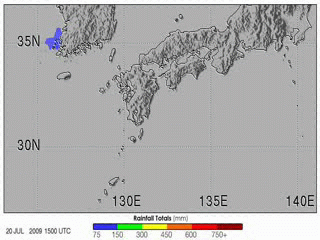Datei:Heavy Rains in Southern Japan.gif
Heavy_Rains_in_Southern_Japan.gif (320 × 240 Pixel, Dateigröße: 8,35 MB, MIME-Typ: image/gif, Endlosschleife, 268 Bilder, 8,0 s)
Hinweis: Aufgrund technischer Beschränkungen werden Vorschaubilder hochauflösender GIF-Dateien wie dieser nicht animiert.
Dateiversionen
Klicke auf einen Zeitpunkt, um diese Version zu laden.
| Version vom | Vorschaubild | Maße | Benutzer | Kommentar | |
|---|---|---|---|---|---|
| aktuell | 23:56, 31. Jul. 2009 |  | 320 × 240 (8,35 MB) | wikimediacommons>Originalwana | {{Information |Description={{en|1=The 2009 summer monsoon brought torrential rains to south western Japan in July. This animatin shows rainfall estimates for southern Japan and the surrounding region from July 20–27. The most prominent feature is a larg |
Dateiverwendung
Die folgenden 2 Seiten verwenden diese Datei:


